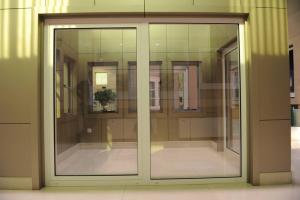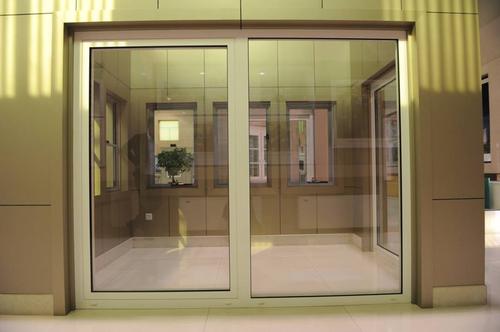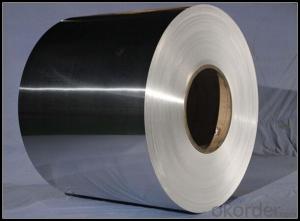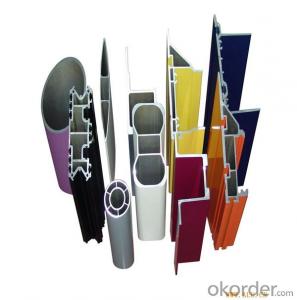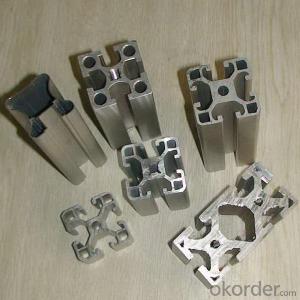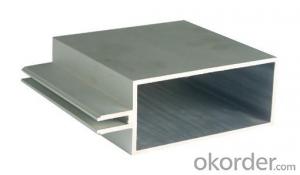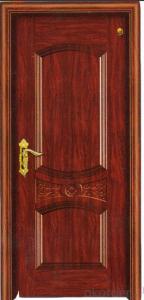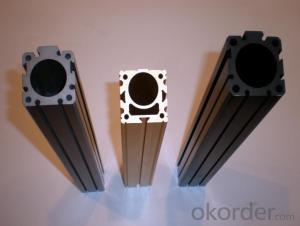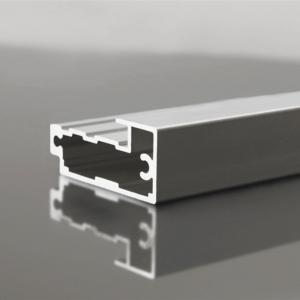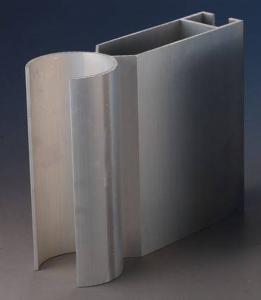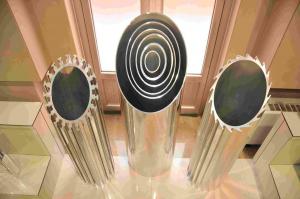Aluminum Window and Door with White Paint - Aluminum Profiles for LED Strips
- Loading Port:
- China Main Port
- Payment Terms:
- TT OR LC
- Min Order Qty:
- -
- Supply Capability:
- -
OKorder Service Pledge
OKorder Financial Service
You Might Also Like
Material introduction
1) 6063-T5 national standard aluminium profile .
2) 95% pure
3) Lengths: 3-6meters, or based on customer requirement
4) Recycling material which is helpful for environment protection
5) Flexible size and shape based on customer's design
Recommend application
1) Exterior of building, pillar, terrace, balcony
2) Airport / bus station, auditorium, music hall, sports center, reception hall
3) Window and door rails and frames
4) Furniture wardrobe rails, frams and kitchen cabinet handles
5) Automatic equipment, profile parts for industrial machines
Technical requirements
1.Standard: GB/75237-2004,Q/320281/PDWD-2008
2.Certification: ISO9001
3.OEM service offered
- Q: This question asks about the various types of aluminum profiles that are specifically used for flooring applications.
- <p>Aluminum profiles for flooring are designed to provide structural support and stability to the flooring system. Common types include: 1. T-profiles, which are used as support beams and can be easily connected to create a grid structure. 2. U-profiles, often used as edge trims or for creating a border around the flooring area. 3. H-profiles, which are suitable for heavy-duty applications and provide high load-bearing capabilities. 4. L-profiles, used for creating corners or edges in flooring systems. 5. C-profiles, which are used for covering or hiding the edges of the floor. Each type offers different benefits and is chosen based on the specific requirements of the flooring project, such as load capacity, aesthetic considerations, and ease of installation.</p>
- Q: This question asks about the various types of surface treatments or finishes that can be applied to aluminum profiles.
- <p>Aluminum profiles can be coated with different types of finishes to enhance their appearance, durability, and resistance to corrosion. Some common types of coatings include: 1. Anodizing, which creates a protective oxide layer on the surface. 2. Powder coating, a durable and colorful finish applied through an electrostatic process. 3. Electrophoretic coating, a method that uses electric current to apply a paint-like coating. 4. PVDF coating, a high-performance finish with excellent weather resistance. 5. Thermal spraying, which applies a coating through a high-velocity flame. 6. Vacuum coating, a process that deposits thin layers of material in a vacuum chamber. Each type of coating has specific properties and applications, making them suitable for different environments and uses.</p>
- Q: Is it possible to utilize recycled aluminum products as an alternative to new ones to decrease environmental impact and save costs?
- <p>Yes, using recycled aluminum products is an effective way to reduce environmental impact and cost. Recycling aluminum requires significantly less energy compared to producing new aluminum from raw materials, which reduces greenhouse gas emissions. Additionally, recycled aluminum retains the same properties as new aluminum, making it a viable alternative for many applications. This practice not only conserves resources but also lowers production costs, making it a sustainable choice for both the environment and your budget.</p>
- Q: What are the aluminum profile manufacturers in Jiangsu?
- I saw a lot of aluminum profile manufacturers on Yi's housekeeper
- Q: How are the tonnage grades of aluminum extrusion machines classified?
- Aluminum material is soft, so it is easy to produce the top injury, pressure injury, scratch and deformation in the stamping production. Besides the requirements on the die, the following points should be done in the stamping process:1, to make aluminum stamping, reducing non-performing rate, the first to do 5S, especially clean, including mold, punch table, pipeline and packaging materials must be no sharp debris, no dirt regularly clear rectification, the upper and lower mold must be clean without debris.2, found that product burr larger, must promptly send mold maintenance, and follow the results.3, aluminum parts easier to heat, and the backlog of hard together, so in the blanking, when the material needs to be coated with a little pressure on the oil (to heat dissipation, but also smooth to clear the material), and then stamping.4, punching more products need to do blow cleaning the mold surface, do product mould, keep clean, reduce top injury, injury must be found on top of the mold top point to find out and solve the injury problems to continue production.5, push the flat mold block will produce aluminum chip, so push block production every day, must be washed under the push block aluminum scrap.Our company with advanced production equipment and technology, relying on a strong technical team, and has established a perfect quality management system, ensure the reliable quality of products, products with first-class quality, reasonable price, sold in the city and region, sales performance is good, whether we are in a peer or in the guest account, have a high reputation.
- Q: What are the electrical insulation properties of aluminum profiles?
- Compared to plastics or ceramics commonly used in electrical applications, aluminum profiles exhibit relatively low electrical insulation properties due to their high conductivity. This attribute allows for the easy flow of electrical current. Nevertheless, with proper precautions, aluminum profiles can still be effectively utilized in electrical applications. Anodizing or coating the profiles with insulating materials like epoxy or polyurethane can significantly enhance their insulation capabilities. These coatings establish a barrier between the aluminum and the electrical current, minimizing the risk of conductivity. Moreover, aluminum profiles can be combined with other insulating materials to achieve the desired level of electrical insulation. For instance, in electrical wiring systems, aluminum conductors are frequently paired with insulating materials such as PVC or cross-linked polyethylene to ensure reliable insulation. It is crucial to recognize that while aluminum profiles may possess lower electrical insulation properties compared to other materials, they do offer other advantageous characteristics like high strength, lightweightness, and corrosion resistance. Hence, careful consideration needs to be given to the specific application and electrical requirements before selecting aluminum profiles as an electrical insulation material.
- Q: This question seeks advice on making the aluminum profile production process eco-friendly.
- <p>To ensure an environmentally friendly production process for aluminum profiles, consider the following: Use recycled aluminum whenever possible to reduce the energy needed for production. Implement energy-efficient technologies and machinery in the production line. Minimize waste by optimizing production processes and recycling any aluminum scraps generated. Employ water-saving measures and treat any wastewater before discharge. Reduce emissions by using low-emission fuels and investing in pollution control equipment. Regularly monitor and assess the environmental impact of your operations and strive for continuous improvement.</p>
- Q: How to identify and distinguish the inferior aluminum profile and the poor aluminum profile four?
- First, extrusion defects.Aluminum extrusion process for machine equipment is perfect, process technology is mature and whether the operation staff misconduct and other reasons, will lead to aluminum flakes, such as inclusion, delamination, chromatic aberration, distortion and other defects, affecting the quality of aluminum profiles.Second, the film thickness is thin.Industrial aluminum oxide film thickness standard should be not less than 10um (m). If the thickness is not enough, the surface of the aluminum profile is easy to rust and corrode and shorten the service life. In order to save the cost, the thickness of the oxide film is only 2 to 4um, and some even have no oxide film. It is estimated that each reduction of 1um film thickness can reduce power consumption by more than 150 yuan per ton.
- Q: Can aluminum profiles be used in HVAC system manufacturing?
- Aluminum profiles are indeed applicable in the manufacturing of HVAC systems. Their lightweight nature, durability, and exceptional thermal conductivity make them highly suitable for HVAC applications. These profiles can be utilized in constructing various components such as air ducts and heat exchangers. Their corrosion resistance is also vital for ensuring the longevity and effectiveness of HVAC systems. Moreover, working with aluminum profiles is effortless, enabling customization and flexibility in the design and construction of HVAC systems. In conclusion, the numerous advantageous properties of aluminum profiles make them a favored option in the manufacturing of HVAC systems.
- Q: What are the different extrusion processes used for aluminum profiles?
- There are several different extrusion processes used for aluminum profiles, each with its own unique advantages and applications. Some of the most common extrusion processes used for aluminum profiles include: 1. Direct extrusion: This is the most common and widely used extrusion process for aluminum profiles. In direct extrusion, a heated aluminum billet is forced through a die to create the desired shape. This process is efficient, cost-effective, and suitable for producing simple to complex profiles with consistent cross-sections. 2. Indirect extrusion: In this process, the billet is held stationary while the die moves, pushing the aluminum through the die to form the profile. Indirect extrusion is often preferred for producing profiles with intricate internal features or when higher surface finish and tighter tolerances are required. 3. Impact extrusion: Impact extrusion is a specialized process used to create hollow aluminum profiles, such as tubes or containers. In this process, a slug of aluminum is placed in a die and a punch is driven into the slug, causing it to flow around the punch and form the desired shape. Impact extrusion is particularly suitable for producing thin-walled profiles with complex shapes. 4. Hydrostatic extrusion: Hydrostatic extrusion is a cold extrusion process that involves forcing the aluminum billet through a die using a high-pressure liquid. This process is often used for producing high-strength aluminum profiles with improved mechanical properties and dimensional accuracy. 5. Hot extrusion: In hot extrusion, the aluminum billet is heated to a temperature above its recrystallization point and then forced through a die. This process is typically used for producing profiles with complex shapes, as the high temperature allows for better material flow and deformation. Each extrusion process offers its own benefits and is chosen depending on the specific requirements of the aluminum profile being produced. Factors such as the desired shape, complexity, surface finish, tolerances, and mechanical properties play a significant role in determining the most suitable extrusion process for aluminum profiles.
Send your message to us
Aluminum Window and Door with White Paint - Aluminum Profiles for LED Strips
- Loading Port:
- China Main Port
- Payment Terms:
- TT OR LC
- Min Order Qty:
- -
- Supply Capability:
- -
OKorder Service Pledge
OKorder Financial Service
Similar products
Hot products
Hot Searches
Related keywords
